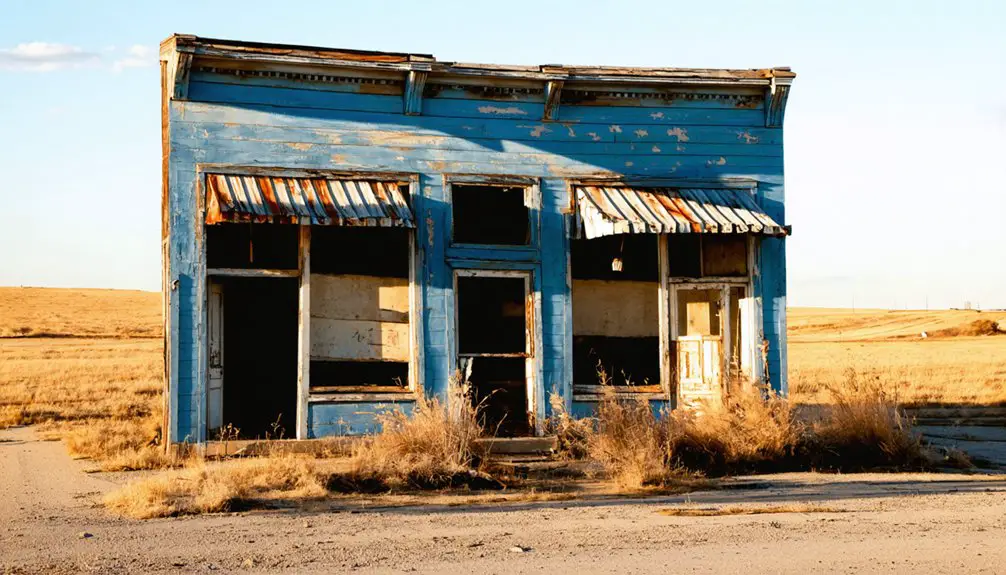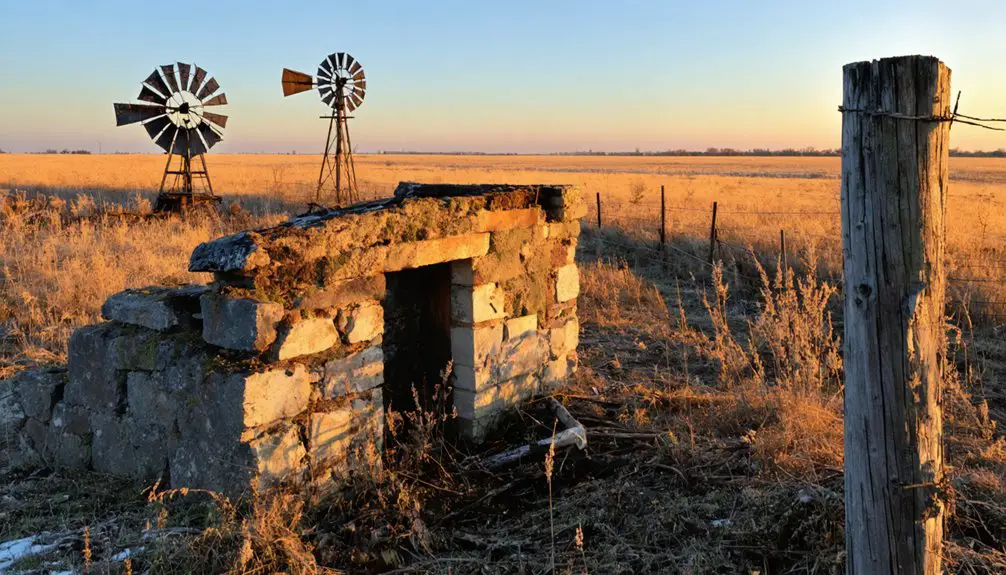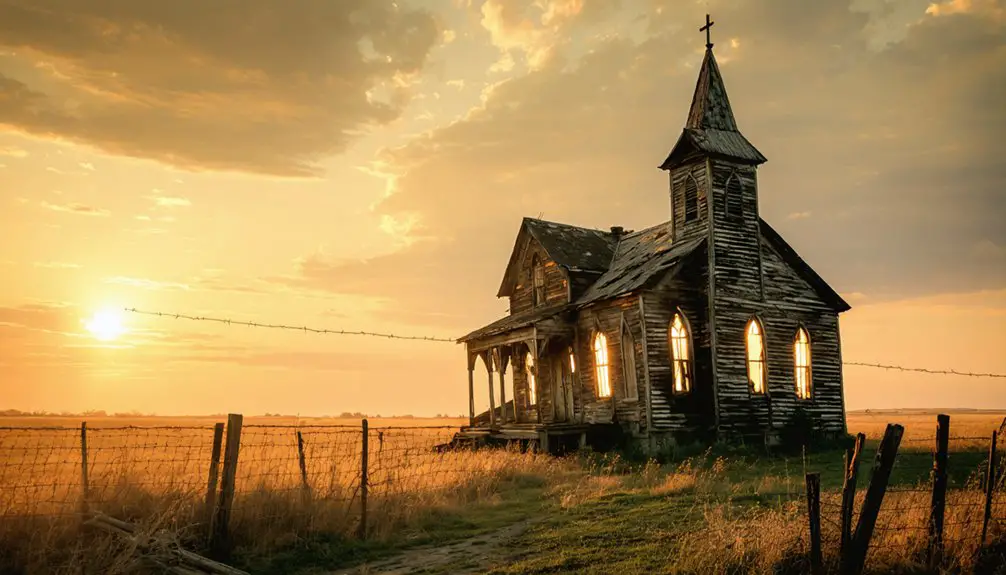You’ll find Smileyberg, Kansas 15 miles southeast of Augusta, where Thomas Smiley and Barney Berg established their settlement in the early 1900s. Berg’s blacksmith shop and Smiley’s general store formed the commercial heart of this prairie community, serving as essential social hubs. Though the town once showed promise, its isolation from railways and limited infrastructure led to its decline. Today, fewer than 100 residents remain among the abandoned structures and weathered remnants of this frontier dream.
Key Takeaways
- Smileyberg is a ghost town in Butler County, Kansas, founded in the early 1900s by Thomas Smiley and Barney Berg.
- The town’s decline began when the Atchison, Topeka and Santa Fe Railroad bypassed it, isolating the community from major transport routes.
- Fewer than 100 residents remain in Smileyberg today, with abandoned structures including a brick high school and decaying residential homes.
- The town’s core businesses were Berg’s blacksmith shop and Smiley’s general store, which served as community hubs until economic decline.
- Located 15 miles southeast of Augusta, Smileyberg’s remnants include cemetery grounds, old street layouts, and deteriorating historic buildings.
The Birth of a Pioneer Settlement
In the early years of the twentieth century, Thomas Smiley and Barney Berg laid the foundation for a new Kansas settlement that would bear their combined names.
The pioneer spirit that drove their venture began in 1904 when Berg purchased 80 acres to establish a blacksmith shop. Smiley followed in 1908, building a modest 16×20-foot store adjacent to Berg’s operation. Smiley’s commitment to reasonable prices and integrity became the cornerstone of his business philosophy. Just as the early settlers of 1868 had done, these entrepreneurs showed remarkable resilience against the harsh frontier conditions.
You’ll find the origins of Smileyberg in these small enterprises that served the surrounding agricultural community. Smiley’s store, initially stocking basic groceries and dry goods, soon expanded to meet growing demand.
From humble shop beginnings, Smileyberg’s early merchants built their success by adapting to the needs of local farmers.
Unlike many railroad-driven boom towns of the era, Smileyberg grew from individual initiative and determination. These two founders created a self-reliant trading center that embodied the entrepreneurial drive of early Kansas settlers.
Location and Geographic Features
You’ll find Smileyberg situated 15 miles southeast of Augusta in rural Butler County, Kansas, where it occupies an 80-acre plot originally owned by Thomas Smiley in Rock Creek Township.
The ghost town‘s relatively flat prairie terrain and proximity to the Walnut River branch made it accessible to early settlers and traders using pioneer pathways.
Historic roads and dirt paths still connect Smileyberg to neighboring communities, preserving the transportation routes that once served this small but bustling settlement. Like many small Kansas settlements, its location allowed for establishing a post office operation, which served the community between 1874-1902. The town gained prominence through its blacksmith shop and automotive services established by the Smiley family.
Rural Butler County Setting
Situated in Rock Creek Township within Butler County, Kansas, Smileyberg occupies the northeast corner of section 21 in the state’s largest county by area.
You’ll find this ghost town amid Butler County’s expansive 1,447 square miles, where the rural heritage remains evident in the scattered farms and open prairies that surround the former settlement.
The area’s agricultural practices thrive on the gently rolling terrain and fertile soils typical of the Central Plains.
Like many settlements of its era including Ayr and Potwin, the movement of post offices often determined a community’s survival in this region.
To avoid confusion with other Butler Counties across the United States, researchers should note this is the Kansas Butler County.
You’re in a region where branches of the Walnut River and various creeks have long supported farming communities, with natural waterways that helped establish early trade routes.
The county’s low population density of 47 people per square mile reflects its enduring rural character, while the climate’s seasonal extremes continue to shape the agricultural rhythms of local life.
Transportation Access Routes
While major highways bypassed the settlement, Smileyberg maintained crucial transportation connections through a network of rural county roads linking it to Augusta, some 15 miles northwest, and other nearby communities. Like many Kansas towns that emerged during land boom settlements, the area’s transportation network evolved to meet changing needs. Many towns faced similar fates when rail access ceased, leading to their gradual decline.
You’ll find evidence of transportation evolution in the area’s shift from horse-drawn vehicles to automobiles, marked by the transformation of the local blacksmith shop into a transmission repair facility.
- Located at the northeast corner of section 21 in Rock Creek Township, you’ll access Smileyberg via gravel and dirt county roads.
- Early road maintenance adapted to the area’s gently rolling terrain, with elevations around 1,300-1,400 feet.
- The presence of historic gas pumps indicates the site’s role as a crucial refueling point.
- Local routes supported agricultural transport and commercial deliveries between farms and regional hubs.
You can still reach Smileyberg today, though limited signage requires local knowledge for navigation.
Early Commerce and Trade
As Smileyberg emerged in the early 1900s, its commercial foundation rested on two key enterprises established by the town’s namesakes. Barney Berg’s blacksmith shop, founded in 1904 on 80 acres in section 21, served the area’s mechanical needs.
Thomas Smiley followed in 1908, building a modest 16×20 foot general store that sold groceries and dry goods. Like many Kansas towns facing population decline and struggles, Smileyberg’s growth was limited by economic challenges of the era.
The trade evolution of Smileyberg centered on these complementary businesses. Smiley’s store rapidly expanded, thanks to his commitment to fair prices, eventually rivaling larger establishments in Douglass and Augusta.
While commerce challenges included limited infrastructure and no permanent post office, the town’s strategic location at a road junction helped sustain local trade.
The blacksmith shop adapted over time, eventually becoming a transmission repair business that operates today.
Daily Life in Early Smileyberg
Life in early Smileyberg revolved around the dual centers of commerce – Berg’s blacksmith shop and Smiley’s general store – where residents gathered not just for goods and services but for social interaction.
You’d find community gatherings happening organically as neighbors met while running their daily chores, sharing news and stories. Living in this frontier town meant adapting to a simple yet challenging lifestyle, where every family played multiple roles to keep the community functioning.
Like other mining settlements of the era, such as Empire City’s 3,000 residents, the population created a bustling atmosphere of activity and enterprise.
- Your weekly schedule would include trips to Smiley’s store for groceries and dry goods.
- You’d rely on Berg’s blacksmith shop for essential repairs and horse shoeing.
- You’d receive mail just once a week, keeping you connected to the outside world.
- You’d travel by wagon or horseback on dirt roads for longer journeys.
- You’d participate in informal social gatherings, with no formal entertainment venues.
From Boom to Abandonment

You’ll find Smileyberg’s initial promise quickly dimmed as the town failed to secure essential railroad connections that powered growth in other Butler County settlements.
The absence of rail transport left Thomas Smiley’s general store and Berg’s blacksmith shop increasingly isolated from larger markets, while Smiley’s personal setbacks in Wichita real estate compounded the town’s struggles.
Pioneer Dreams Fade Away
While Thomas Smiley and Barney Berg held ambitious dreams for their fledgling settlement in the early 1900s, Smileyberg’s promising start would ultimately succumb to economic fragility and limited growth potential.
You can trace the fading memories of pioneer aspirations through the remnants of their initial entrepreneurial efforts – from Berg’s blacksmith shop to Smiley’s modest general store that once served the rural community.
- The town’s reliance on basic agricultural services couldn’t sustain long-term growth.
- Without railroad connections or industrial development, broader market integration proved impossible.
- The Wichita real estate crash dealt a devastating blow to Thomas Smiley’s financial stability.
- Limited public infrastructure made it difficult to retain residents seeking better opportunities.
- The transmission shop that operates today stands as the last echo of commerce in this ghost town.
Missed Railroad Opportunities
Despite early hopes of becoming a thriving railroad town, Smileyberg’s fate was sealed when the Atchison, Topeka and Santa Fe Railroad chose routes that bypassed the fledgling settlement. The railroad decisions favored established towns and major cities, leaving Smileyberg isolated from essential transportation networks.
The economic consequences proved devastating. Without a local station, you wouldn’t have found the bustling commerce that transformed other Kansas towns into regional hubs. Local merchants struggled to ship goods, while farmers couldn’t efficiently transport their harvests.
The town never secured a proper post office or regular passenger service, making it increasingly unattractive to potential settlers. As automobile transport rose and railroad networks consolidated, Smileyberg’s isolation only deepened.
What could have been a prosperous community withered as neighboring towns with rail access flourished.
Small Business Goes Silent
When Thomas Smiley and Barney Berg established their pioneering businesses in the early 1900s, they couldn’t have foreseen their town’s eventual silence. The small business landscape they created – a bustling store and blacksmith shop – initially thrived in Smileyberg’s rural economy.
Yet, the economic impact of financial setbacks, including Smiley’s losses in the Wichita real estate crash, began a slow decline that would eventually hollow out the town’s commercial core.
- Smiley’s 16×20 foot store expanded rapidly, offering groceries and dry goods
- Berg’s blacksmith services supported the agricultural community
- Local merchants operated within a modest, farming-dependent economy
- Limited population and transportation routes constrained growth potential
- By mid-20th century, businesses had faded into ghost town status
What Remains Today

As you venture into present-day Smileyberg, you’ll find a haunting collection of abandoned structures that tell the story of this once-thriving Kansas town. The brick high school stands as a deteriorating sentinel, while scattered residential homes – most in various states of decay – dot the quiet landscape.
Crumbling brick walls and decaying homes stand as silent guardians of Smileyberg’s faded glory, frozen in time.
You’ll spot traces of the old railroad lines that once brought life to this community, though most of the infrastructure has vanished.
Today, fewer than 100 residents call this remote Butler County location home. While ghost town tourism and historic preservation efforts have sparked interest in places like Smileyberg, you’ll find little activity here beyond agricultural operations in the surrounding fields.
The cemetery and old street layouts remain as silent witnesses to a bustling past, now accessible only by winding back roads.
Frequently Asked Questions
Did Smiley and Berg’s Families Continue Living in the Area After Its Decline?
You can’t be completely certain about the family legacy, though records show a small local presence remains through a transmission shop, but there’s no clear evidence of direct Smiley or Berg descendants.
Were There Any Notable Crimes or Lawless Incidents in Smileyberg’s History?
You won’t find any documented crime statistics or notable lawless incidents in historical records. There’s no evidence of significant law enforcement activity during the town’s short-lived existence.
What Native American Tribes Originally Inhabited the Land Where Smileyberg Was Built?
You’ll find the Osage dominated this tribal history, while Kansa and Wichita peoples also claimed land significance in the area before Smileyberg’s establishment. These tribes shared the region’s resources.
Did the Great Depression Play a Significant Role in Smileyberg’s Eventual Decline?
Yes, you’ll find the Depression dealt a significant economic impact to Smileyberg, weakening community resilience through widespread unemployment, agricultural challenges, and population loss that accelerated the town’s eventual abandonment.
Were There Any Known Natural Disasters That Affected Smileyberg’s Development?
Despite Butler County facing over 50 severe weather events annually, you won’t find documented natural disaster impacts on Smileyberg’s development. The town’s decline wasn’t linked to any specific weather events.
References
- https://www.ksgenweb.org/archives/butler/history/1916/33/s/smiley_thomas.html
- https://www.youtube.com/watch?v=iB5rHT14eVI
- https://legendsofkansas.com/butler-county-extinct-towns/
- https://www.youtube.com/watch?v=nOOEY5ClP7Q
- https://freepages.rootsweb.com/~gtusa/history/usa/ks.htm
- https://swissmennonite.org/wp-content/uploads/2018/11/Pioneer-Life-and-Lore-of-McPherson-County-Kansas-Wayne-digitized-072617.pdf
- http://genealogytrails.com/kan/butler/historyofbutler12.html
- https://www.therockerbox.com/butler_county_ks_ghost_towns.htm
- https://www.youtube.com/watch?v=VPZtNoncnig
- https://en.wikipedia.org/wiki/List_of_ghost_towns_in_Kansas



